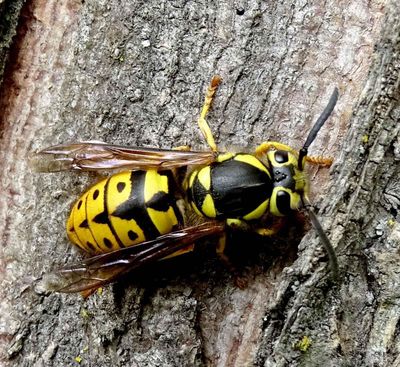Rich Landers: Yellow jackets are wild friends with attitude

They are well-known for the venom they can deliver in multiple stings.
You never forget the first time you ride a horse over a wasp nest or your child is nailed in the lip by a yellow jacket that was exploring the inside of an idled pop can.
So brace yourself: mid- to late-summer is their peak of aggressiveness.
Yellow jackets generally have been focused on nesting in remodeled abandoned rodent burrows since spring. And let’s not forget that bald-faced hornets, which can have even darker attitudes, have been devoted to making babies in gray football-shaped nests that often hang in trees.
Once the nests reach full size, the queens start laying the eggs that develop into the males and females that will leave the colony, mate, and begin the cycle again the next year.
These workers, and the year-old queen, by now have died or are dying.
Meanwhile, this season’s workers are focused on protecting the colony’s future of new males and virgin queens in the nest. They take their job seriously.
They’re out beefing up their insect diet with carrion, which to them resembles the rotting food in a garbage dumpster or the meal on your picnic table. No offense.
Yellow jackets at picnics are not likely to sting people unless they’re intentionally or accidentally threatened.
Their aggressive behavior is reserved mostly for defending the nest. Pass too close or linger too long in a certain spot and you’ll find out.
Stings are an occupational hazard for bird dog trainer Dan Hoke. “We had a pretty big setback with one dog that came nicely on point, but right over a yellow jacket nest,” Hoke said. “He started getting nailed in the belly and all over. The dog almost certainly thought I had something to do with it and that he was doing something wrong.
“That’s one of training’s worst-case scenarios.”
This year’s abundance of stinging wasps has been nothing compared with the summer of 2013, when every outdoorsman seemed to have a war story from angling on the Coeur d’Alene River to camping at Lake Pend Oreille.
Fly fishing guide G.L. Britton said it was as bad a year for yellow jackets as he could remember in his career. But he found at least one ally.
“I’d seen pics of hummingbirds tongue-lassoing wasps ahead of the stingers and slicing off the danger,” he said. In August that year, he got an up-close and personal demonstration.
“A rufous hummer took a wasp three feet from my face,” he said. “After five seconds of squealing with action so fast I couldn’t discern the strategy, the bird swallowed it.”
Despite the occasional clash, yellow jackets are our friends.
They work daily to reduce the number of destructive caterpillars, bark beetles and other insects that try to gnaw away our gardens and forests.
I learned a measure of their importance years ago during an expedition through the Arctic National Wildlife Refuge in Alaska, where clouds of mosquitoes can cast shadows on a clear day.
My two companions and I had a routine when we piled into the tent in the land of 24-hour daylight. We would flail arms and brush skeeters off one person, unzip the tent, let him dive in and then shut the tent and repeat. Once we were all inside, we’d go on a rampage of slapping and squishing to kill the many mosquitoes that sneaked into our refuge.
As the action subsided one day, I noticed a yellow jacket outside buzzing at the tent door bug netting. I scooted within inches of the action and saw it catch a mosquito and land on the netting with the skeeter in its mouth. The yellow jacket consumed the prey in eight chomps.
Then it hovered inches off the netting, caught another skeeter and landed. I moved my face within inches to once again see its fearsome mouth parts ingest the bug in eight chomps.
This repeated numerous times before the wasp left.
“He’s on our side,” I told my partners over the droning buzz of insects outside the tent. “We need all the friends we can get.”